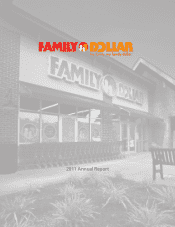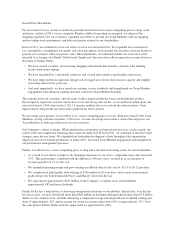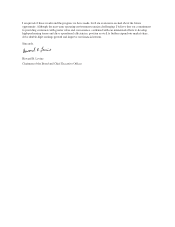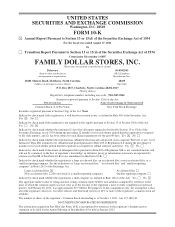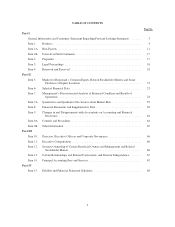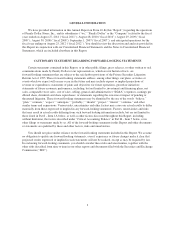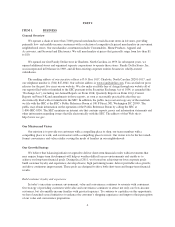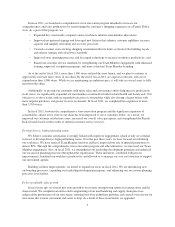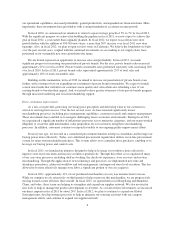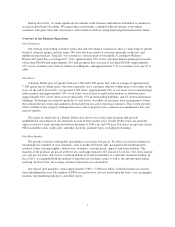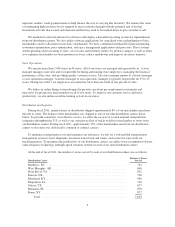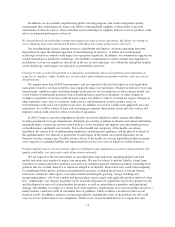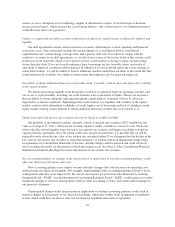Family Dollar 2011 Annual Report Download - page 10
Download and view the complete annual report
Please find page 10 of the 2011 Family Dollar annual report below. You can navigate through the pages in the report by either clicking on the pages listed below, or by using the keyword search tool below to find specific information within the annual report.our operational capabilities, increased profitability, gained productivity, and expanded our financial returns. More
importantly, these investments have provided us with a strong foundation to accelerate revenue growth.
In fiscal 2010, we announced our intention to return to square footage growth of 5% to 7% by fiscal 2013.
With the significant progress we achieved in building the pipeline in fiscal 2011, we now expect to achieve this
goal in fiscal 2012, a year earlier than originally planned. In fiscal 2012, we expect to accelerate new store
growth further with the addition of 450-500 new stores, a more than 50% increase over fiscal 2011 new store
openings. Also, in fiscal 2012, we plan to open our first stores in California. We believe the foundation we built
over the past several years, coupled with the continued investments we are making to our supply chain, have
positioned us for sustainable new store growth into the future.
Private brands represent an opportunity to increase sales and profitability. In fiscal 2011, we made
significant progress in increasing our penetration of private brands. For the year, private brands sales increased
approximately 22% over fiscal 2010. Private brands consumable sales performed especially well, increasing 26%
over fiscal 2010. In fiscal 2011, private brands sales represented approximately 25% of total sales and
approximately 16% of total consumable sales.
Building on this momentum, in fiscal 2012 we intend to increase our penetration of private brands even
further, with a stronger focus on expanding our assortment of private brand consumables. We expect to launch
several new brands that will offer our customers more quality and value while also refreshing a few of our
existing brands to broaden their appeal. And, we intend to drive greater awareness of our private brands program
through increased marketing and visual merchandising support.
Drive continuous improvement
As a low-cost provider, protecting our strong price perception and delivering value to our customers is
critical to our long-term success. Over the last several years, we have invested significantly in new
merchandising processes, including price management capabilities, customer research and category management.
These investments have enabled us to navigate challenging macro-economic environments. During fiscal 2011,
we experienced a significant number of inflationary pressures across numerous categories, and our teams worked
diligently to create the right merchandise value proposition for our customers using these merchandising
processes. In addition, customers continue to respond favorably to our ongoing quality-improvement efforts.
Several years ago, we invested in a centralized procurement function to help us consolidate and leverage our
buying power more effectively. Today, our centralized procurement organization utilizes an on-line procurement
system for many non-merchandise purchases. This system allows us to centralize these purchases, enabling us to
leverage our buying power and control costs.
In fiscal 2011, we launched an initiative designed to help us leverage our workforce more effectively,
improve store-level execution and increase workforce productivity. Through this effort, we re-engineered many
of our core store processes, including shelf re-stocking, the check-out experience, store recovery and in-store
merchandising. Through the application of new technology and processes, we implemented new time and
attendance procedures, addressed workflow and task management, and improved store-level execution. This has
allowed us to more effectively manage store labor, a significant portion of our core expenses.
In fiscal 2011, approximately 31% of our purchased merchandise (at cost) was manufactured overseas.
While we continue to rely extensively on third parties to help us procure this merchandise, we are progressively
moving toward a more efficient, direct model. In fiscal 2011, we opened offices in Hong Kong and Shenzhen,
China, and today, these teams are helping us strengthen and expand our supplier network. We also invested in
new tools to help us manage the product development cycle better. As a result of these investments, we increased
our direct imports in fiscal 2011 by about 24%. In fiscal 2012, we plan to continue to expand our Global
Sourcing teams, develop stronger processes to help us integrate our sourcing activities with our category
management efforts, and continue to expand our supplier network.
6

